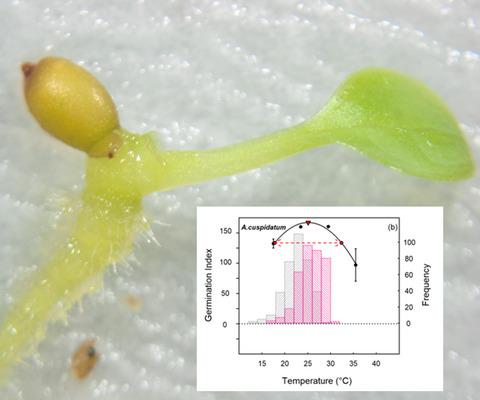当前位置:
X-MOL 学术
›
Plant Biol.
›
论文详情
Our official English website, www.x-mol.net, welcomes your feedback! (Note: you will need to create a separate account there.)
Temperature dependence of germination and growth in Anthurium (Araceae).
Plant Biology ( IF 3.9 ) Pub Date : 2019-12-10 , DOI: 10.1111/plb.13063 G Zotz 1, 2 , N Kappert 1 , L-L B Müller 1 , K Wagner 1
Plant Biology ( IF 3.9 ) Pub Date : 2019-12-10 , DOI: 10.1111/plb.13063 G Zotz 1, 2 , N Kappert 1 , L-L B Müller 1 , K Wagner 1
Affiliation

|
By the year 2100, temperatures are predicted to increase by about 6 °C at higher latitudes and about 3 °C in the tropics. In spite of the smaller increase in the tropics, consequences may be more severe because the climatic niches of tropical species are generally assumed to be rather narrow due to a high degree of climate stability and higher niche specialisation. However, rigorous data to back up this notion are rare. We chose the megadiverse genus Anthurium (Araceae) for study. Considering that the regeneration niche of a species is crucial for overall niche breadth, we focused on the response of germination and early growth through a temperature range of 24 °C of 15 Anthurium species, and compared the thermal niche breadth (TNB) with the temperature conditions in their current range, modelled from occurrence records. Surprisingly, an increase of 3 °C would lead to a larger overlap of TNB of germination and modelled in situ temperature conditions, while the overlap of TNB of growth with in situ conditions under current and future conditions is statistically indistinguishable. We conclude that future temperatures tend to be closer to the thermal optima of most species. Whether this really leads to an increase in performance depends on other abiotic and biotic factors, most prominently potentially changing precipitation patterns.
中文翻译:

红掌(天南星科)发芽和生长的温度依赖性。
到2100年,高纬度地区的温度预计将上升约6°C,而热带地区的温度将上升约3°C。尽管热带地区的增长幅度较小,但后果可能更为严重,因为由于高度的气候稳定性和较高的生态位专业化程度,热带物种的生态位通常被认为是相当狭窄的。但是,很少有支持此概念的严格数据。我们选择了大型生物红掌属(天南星科)进行研究。考虑到物种的再生生态位对于整体生态位宽度至关重要,因此我们重点研究了15个红掌物种在24°C的温度范围内萌发和早期生长的响应,并将热生态位宽度(TNB)与温度进行了比较。根据发生记录建模的当前范围内的条件。出奇,3°C的升高将导致发芽的TNB和在原位温度条件下建模的较大重叠,而在当前和将来的条件下,生长的TNB与原位条件的重叠在统计上是无法区分的。我们得出结论,未来的温度趋向于接近大多数物种的热最适温度。这是否真的导致性能提高取决于其他非生物和生物因素,最显着的是可能会改变降水模式。
更新日期:2019-12-10
中文翻译:

红掌(天南星科)发芽和生长的温度依赖性。
到2100年,高纬度地区的温度预计将上升约6°C,而热带地区的温度将上升约3°C。尽管热带地区的增长幅度较小,但后果可能更为严重,因为由于高度的气候稳定性和较高的生态位专业化程度,热带物种的生态位通常被认为是相当狭窄的。但是,很少有支持此概念的严格数据。我们选择了大型生物红掌属(天南星科)进行研究。考虑到物种的再生生态位对于整体生态位宽度至关重要,因此我们重点研究了15个红掌物种在24°C的温度范围内萌发和早期生长的响应,并将热生态位宽度(TNB)与温度进行了比较。根据发生记录建模的当前范围内的条件。出奇,3°C的升高将导致发芽的TNB和在原位温度条件下建模的较大重叠,而在当前和将来的条件下,生长的TNB与原位条件的重叠在统计上是无法区分的。我们得出结论,未来的温度趋向于接近大多数物种的热最适温度。这是否真的导致性能提高取决于其他非生物和生物因素,最显着的是可能会改变降水模式。

























 京公网安备 11010802027423号
京公网安备 11010802027423号